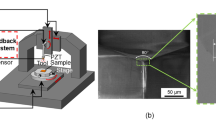Abstract
Single-point diamond cutting is an efficient method to fabricate microlens arrays (MLAs). However, machining MLAs at the microscale with high dimensional accuracy and a smooth surface finish is a difficult task. In this study, a method of profile cutting is proposed to machine MLAs on electroless nickel–phosphorus (Ni–P) plating. To improve the dimensional accuracy of MLAs, a precision tool setting method is introduced, via which the precision of MLA sag can be controlled to within 20 nm. In addition, the formation mechanism of corrugation defects is studied via a finite element (FE) simulation of the wedge nano-cutting process and a cutting experiment of concentric ring grooves. By optimizing the tool settings and the machining parameters, high-quality MLAs with apertures of Φ100 μm can be created.




















Similar content being viewed by others
Data availability
All data are presented within the manuscript.
References
Pan JW, Wang CM, Lan HC, Sun WS, Chang JY (2007) Homogenized LED-illumination using microlens arrays for a pocket-sized projector. Opt Express 15(17):50483–50491. https://doi.org/10.1364/OE.15.010483
Gallagher NC, Roychoudhuri CS (1993) Miniature and micro-optics and micromechanics. In: Miniature and micro-optics and micromechanics, vol. 1992. https://spie.org/Publications/Proceedings/Volume/1992?SSO=1. Accessed 15 Dec 2020
Dong X, Zhou T, Pang S, Liang Z, Yu Q, Ruan B, Wang X (2019) Comparison of fly cutting and transverse planing for micropyramid array machining on nickel phosphorus plating. Int J Adv Manuf Technol 502:2481–2489. https://doi.org/50.5007/s00170-019-03335-8
Zhou T, Xu R, Ruan B, Liang Z, Wang X (2018) Fabrication of microlens array on 6H-SiC mold by an integrated microcutting-etching process. Precis Eng 54(2018):314–320. https://doi.org/50.5016/j.precisioneng.2018.06.008
Yan J, Zhou T, Masuda J, Kuriyagawa T (2009) Modeling high-temperature glass molding process by coupling heat transfer and viscous deformation analysis. Precis Eng 33(2):150–159. https://doi.org/10.1016/j.precisioneng.2008.05.005
Zhou T, Yan J, Masuda J, Kuriyagawa T (2011) Investigation on shape transferability in ultraprecision glass molding press for microgrooves. Precis Eng 35(2):214–220. https://doi.org/10.1016/j.precisioneng.2010.09.011
Xie J, Zhou T, Ruan B, Du Y, Wang X (2017) Effects of interface thermal resistance on surface morphology evolution in precision glass molding for microlens array. Appl Opt 56(23):6622–6628. https://doi.org/10.1364/AO.56.006622
Zhou T, Ruan B, Zhou J, Dong X, Wang X (2019) Mechanism of brittle fracture in diamond turning of microlens array on polymethyl methacrylate. Adv Manuf 7:228–237 https://doi.org.org/50.5007/s40436-019-00260-7
Aono Y, Negishi M, Takano J (2000) Development of large-aperture aspherical lens with glass molding. Proc SPIE Int Soc Opt Eng 4231:16–23. https://doi.org/10.1117/12.402759
Albero J, Nieradko L, Gorecki C, Ottevaere H, Passilly N (2009) Fabrication of spherical microlenses by a combination of isotropic wet etching of silicon and molding techniques. Opt Express 17:6283–6292. https://doi.org/10.1364/OE.17.006283
Oliveira OG, Monteiro DW, Costa RFO (2014) Optimized microlens-array geometry for Hartmann-Shack wavefront sensor. Opt Lasers Eng 55:155–161. https://doi.org/10.1016/j.optlaseng.2013.11.006
Ow YS, Breese MBH, Azimi S (2050) Fabrication of concave silicon micro-mirrors. Opt Express 18:14511–14518. https://doi.org/10.1364/OE.18.014511
Deng Z, Yang Q, Chen F, Meng X, Bian H (2015) Fabrication of large-area concave microlens array on silicon by femtosecond laser micromachining. Opt Lett 40:1928–1931. https://doi.org/10.1364/OL.40.001928
Weck M, Hennig J, Hilbing R (2001) Precision cutting processes for manufacturing of optical components. SPIE 4440:145–151. https://doi.org/10.1117/12.448034
Yi AY, Li L (2005) Design and fabrication of a microlens array by use of a slow tool servo. Opt Lett 30(13):1707–1709. https://doi.org/10.1364/OL.30.001707
Yu DP, Hong GS, Wong YS (2012) Profile error compensation in fast tool servo diamond turning of micro-structured surfaces. Int J Mach Tool Manu 52(1):13–23. https://doi.org/10.1016/j.ijmachtools.2011.08.010
Yan J, Zhang Z, Kuriyagawa T, Gonda H (2010) Fabricating micro-structured surface by using single-crystalline diamond end mill. Int J Adv Manuf Technol 51(9−12):957–964. https://doi.org/10.1007/s00170-010-2695-2
Mao M, Jiwang Y (2017) Fabrication of hexagonal microlens arrays on single-crystal silicon using the tool-servo driven segment turning method. Micromachines-Basel 8(11):323. https://doi.org/10.3390/mi8110323
Yan J, Oowada T, Zhou T, Kuriyagawa T (2009) Precision machining of microstructures on electroless-plated Ni–P surface for molding glass components. J Mater Process Technol 209(50):4802–4808. https://doi.org/10.1016/j.jmatprotec.2008.12.008
Jiang X, Li B, Yang J, Zuo X, Li K (2013) An approach for analyzing and controlling residual stress generation during high-speed circular milling. Int J Adv Manuf Technol 66(9-12):1439–1448. https://doi.org/10.1007/s00170-012-4421-8
Acknowledgements
The authors would also like to acknowledge the support from the Fok Ying-Tong Education Foundation for Young Teachers in the Higher Education Institutions of China (No. 151052).
Code availability
Not applicable.
Funding
This work has been financially supported by the National Natural Science Foundation of China (Nos. 51775046 and 51875043) and Beijing Municipal Natural Science Foundation (JQ20015).
Author information
Authors and Affiliations
Contributions
Tianfeng Zhou and Benshuai Ruan: conceptualization, formal analysis, investigation, writing—original draft, and visualization. Qian Yu, Jia Zhou, Peng Liu, and Wenxiang Zhao: conceptualization, supervision, and writing—review and editing. Xibin Wang: conceptualization and writing—review and editing.
Corresponding author
Ethics declarations
Ethical approval
The article follows the guidelines of the Committee on Publication Ethics (COPE) and involves no studies on human or animal subjects.
Consent to participate
Not applicable. The article involves no studies on humans.
Consent to publish
Not applicable. The article involves no studies on humans.
Competing interests
The authors declare no competing interests.
Additional information
Publisher’s note
Springer Nature remains neutral with regard to jurisdictional claims in published maps and institutional affiliations.
Rights and permissions
About this article
Cite this article
Zhou, T., Ruan, B., Yu, Q. et al. Improvement of dimensional accuracy and surface quality of microlens arrays by a profile cutting method. Int J Adv Manuf Technol 115, 1877–1888 (2021). https://doi.org/10.1007/s00170-021-07072-9
Received:
Accepted:
Published:
Issue Date:
DOI: https://doi.org/10.1007/s00170-021-07072-9




